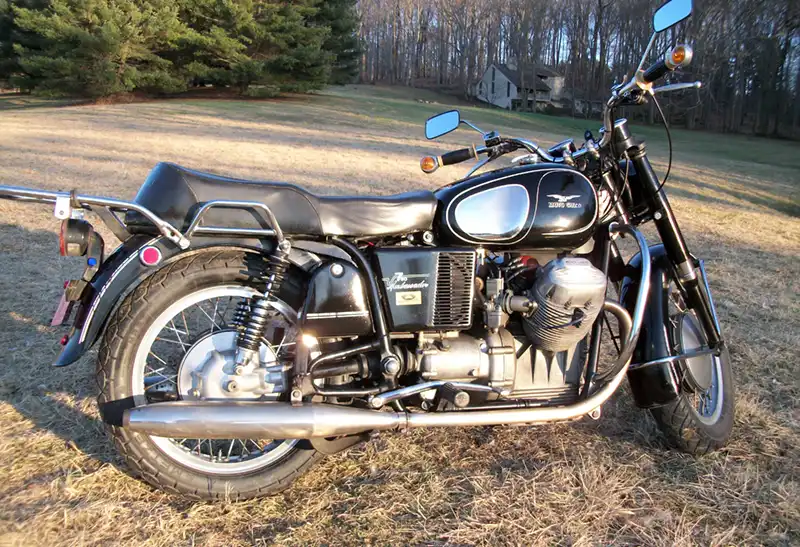 As I recall, it was back in ’89 or ’90 that a customer brought this bike into the service department. It hadn’t run in 15 years or more, and looked horrible: a rusty hulk festooned with cheap, poorly mounted accessories, extra lights and frilly things. I asked for $50 to look things over carefully and come up with a war plan. The first major battle involved repairing the dead starter motor, cleaning the sump, carbs and tank (did I mention that there were actual mushrooms growing inside the tank?) and getting it to run. A $500 estimate for this work was accepted, payment promised and the work performed.
As I recall, it was back in ’89 or ’90 that a customer brought this bike into the service department. It hadn’t run in 15 years or more, and looked horrible: a rusty hulk festooned with cheap, poorly mounted accessories, extra lights and frilly things. I asked for $50 to look things over carefully and come up with a war plan. The first major battle involved repairing the dead starter motor, cleaning the sump, carbs and tank (did I mention that there were actual mushrooms growing inside the tank?) and getting it to run. A $500 estimate for this work was accepted, payment promised and the work performed.
The next chapter involved the service department’s annual auction, where the year’s accumulated abandoned bikes are sold to the highest bidder. The Guzzi’s owner had bailed, having evidently developed second thoughts about the wisdom of investing in this project. I had developed a connection to this bike, as a close friend had owned the same model back in the early 70’s, and I had ridden his just enough to know that it was something special. So, when this Guzzi came onto the block, I bought it.
I think it had about 45,000 miles showing on the odometer then. It now shows 84,000, and still runs well on the original rings and valves. Basically, the motor has yet to come apart for repairs. This makes the Guzzi the most senior bike in the RetroTours collection, and begs the question: How could anything rack up that kind of trouble-free mileage considering the neglect and abuse it had suffered?
The answer is in history, when the Italian army needed a Jeep-like utility vehicle during WWII. Moto Guzzi developed a three-wheeled contraption that could climb the steepest grades, powered by a robust V-twin motor built to automotive/agricultural standards: designed to last practically forever. Availability must trump practicality, for somehow this lump of an engine found its way into a motorcycle frame several years later. The resulting stone-reliable shaft-drive machine was used extensively by military and police forces in Italy and, ultimately, around the world, including the California Highway Patrol.
This old-world engine layout has a lot going for it, placing the exhaust ports and under-stressed cylinders right out into the cooling air stream, like a flat twin but with less width. The 90 degree V angle gives perfect primary balance and the associated excellent smoothness at road speed. The huge heel/toe shifter, however, connects via a sloppy linkage to one of the most cumbersome transmissions ever devised. Fortunately, the motor produces useable power over a very wide RPM range, for the time spent between gears can be lengthy, as the rider waits for shaft speeds to match before clunking into the next cog. Sometimes, the noises from the gearbox are so pronounced that riders on nearby bikes wince, but things can smooth out with practice.
The frame tying this all together is typical Old Italian: on the heavy side, but very stout, with geometry that gives great stability with slow steering. The starter and belt-driven alternator are the same Bosch units used on Volkswagen cars. The sprung-and-padded seat is one of the best of all time, and good for all day. The double-leading-shoe front and rear brakes are typical of the era, but the front has been fitted with custom high- friction linings to better deal with modern traffic. The suspension is dated now, but was considered top notch in its day. As a whole, the Guzzi feels as venerable as its colorful history, and gives a rock-steady ride that is quite pleasant, so long as the rider does not try to hurry things too much. Think of it as a Spaghetti Harley-Davidson.

